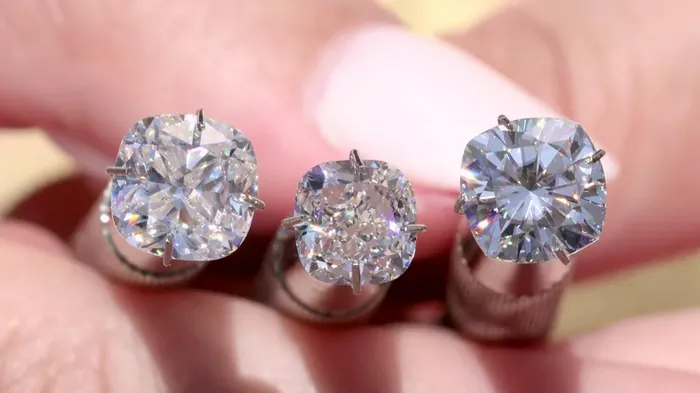In recent years, the jewelry industry has seen a significant rise in the popularity of alternative gemstones and diamonds. Among these, moissanite and lab-created diamonds have emerged as prominent choices. Both offer distinct advantages and appeal to different preferences and needs. This comprehensive guide delves into the comparison of moissanite and lab-created diamonds, exploring their characteristics, benefits, and drawbacks to help you make an informed decision.
1. Understanding Moissanite
1.1. Origin and Composition
Moissanite is a gemstone made of silicon carbide. It was first discovered in 1893 by French chemist Henri Moissan, who found it in a meteor crater. Natural moissanite is exceedingly rare, so most moissanite available today is synthetically produced. The process involves heating silicon and carbon to high temperatures in a laboratory setting.
1.2. Characteristics
Hardness: Moissanite is remarkably hard, scoring 9.25 on the Mohs scale of hardness, making it one of the hardest gemstones available. This hardness ensures its durability and resistance to scratching.
Brilliance: Moissanite has a higher refractive index (2.65-2.69) compared to diamonds (2.42), giving it exceptional brilliance and sparkle. Its ability to reflect light creates a fire-like sparkle that can be more intense than that of diamonds.
Color: Moissanite can come in various colors, from near-colorless to shades of green and yellow. The most popular and valuable moissanites are those that are near-colorless or have a slight tint.
1.3. Price
Moissanite is generally more affordable than diamonds. The cost of moissanite is significantly lower per carat compared to lab-created diamonds, making it an attractive option for those on a budget.
2. Understanding Lab-Created Diamonds
2.1. Origin and Creation
Lab-created diamonds, also known as synthetic diamonds, are produced in controlled laboratory environments using two primary methods: High Pressure High Temperature (HPHT) and Chemical Vapor Deposition (CVD). These methods replicate the natural processes that form diamonds deep within the Earth.
HPHT: This method mimics the high pressure and temperature conditions found in the Earth’s mantle. Carbon is crystallized under these extreme conditions to form diamonds.
CVD: This method involves placing a diamond seed in a chamber where carbon gases are introduced. The gases are then ionized to deposit carbon atoms onto the seed, forming diamond crystals layer by layer.
2.2. Characteristics
Hardness: Lab-created diamonds are identical to natural diamonds in terms of hardness, scoring a perfect 10 on the Mohs scale. This makes them highly durable and suitable for everyday wear.
Brilliance: Lab-created diamonds have the same refractive index as natural diamonds, providing a comparable level of brilliance and sparkle. Their light performance is virtually identical to that of natural diamonds.
Color: Lab-created diamonds come in a range of colors, from colorless to various shades. The color grading of lab-created diamonds follows the same scale as natural diamonds, and they can be chosen based on personal preference and budget.
2.3. Price
Lab-created diamonds are typically less expensive than natural diamonds, but their pricing is generally higher than that of moissanite. The cost reflects the intricate technology and processes involved in their creation.
3. Comparing Moissanite and Lab-Created Diamonds
3.1. Appearance
The visual appeal of moissanite and lab-created diamonds can be quite different. Moissanite’s higher refractive index often results in more fire and brilliance compared to lab-created diamonds. However, this intense sparkle may be a matter of personal preference. Some people prefer the classic, subdued brilliance of diamonds, while others appreciate the unique sparkle of moissanite.
3.2. Durability
Both moissanite and lab-created diamonds are highly durable. Moissanite’s hardness makes it resistant to scratches, while lab-created diamonds offer the same level of durability as natural diamonds. For practical purposes, either choice will hold up well under everyday wear.
See Also: A Guide to Choose the Most Secure Clasp for Hoop Earrings
3.3. Cost
Moissanite is generally more affordable than lab-created diamonds. If budget is a significant factor, moissanite may be the better choice. Lab-created diamonds, while more expensive, offer the appeal of a traditional diamond at a lower price than natural diamonds.
3.4. Ethical Considerations
Both moissanite and lab-created diamonds offer ethical advantages over natural diamonds. Moissanite’s production does not involve mining, and lab-created diamonds avoid many of the ethical issues associated with diamond mining, such as environmental damage and conflict diamonds.
3.5. Resale Value
Lab-created diamonds may have better resale value compared to moissanite, though neither typically matches the resale value of natural diamonds. Moissanite’s lower price point means it may not retain its value as well as lab-created diamonds, which are more closely associated with traditional diamonds.
4. Making the Right Choice
4.1. Personal Preference
Choosing between moissanite and lab-created diamonds ultimately comes down to personal preference. Consider factors such as the type of brilliance you prefer, your budget, and the importance of ethical sourcing. Moissanite’s exceptional sparkle might appeal to those seeking a unique look, while lab-created diamonds offer the classic diamond experience.
4.2. Purpose and Setting
Think about the purpose of the gemstone and the setting in which it will be used. Moissanite’s affordability makes it a popular choice for engagement rings and fashion jewelry, while lab-created diamonds may be preferred for heirloom-quality pieces.
4.3. Future Considerations
Consider how the choice may impact future decisions, such as resale value and potential upgrades. Lab-created diamonds might offer more flexibility in this regard, but moissanite’s affordability makes it a cost-effective option with its own set of advantages.
Conclusion
Both moissanite and lab-created diamonds offer compelling benefits and cater to different needs and preferences. Moissanite is celebrated for its extraordinary brilliance and affordability, making it a popular choice for those seeking a unique and budget-friendly option. Lab-created diamonds, on the other hand, provide the classic diamond experience with the added benefit of ethical and environmental considerations.
Ultimately, the decision between moissanite and lab-created diamonds should be based on your personal preferences, budget, and values. Whether you choose the dazzling sparkle of moissanite or the timeless appeal of a lab-created diamond, both choices represent a modern and ethical approach to fine jewelry.

